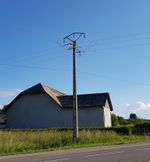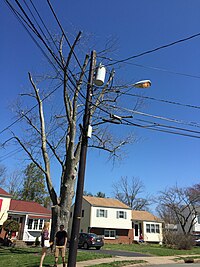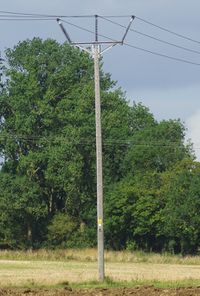Tag:power=pole
| Description |
|---|
| A single pole supporting power lines, often a wood, steel, or concrete mast designed to carry minor power lines. |
| Rendering in OSM Carto |
| Group: power |
| Used on these elements |
| Implies |
| Useful combination |
|
| See also |
| Status: de facto |
| Tools for this tag |
|
A single (often wooden or concrete) pole carrying low voltage, medium voltage, or high voltage lines (usually of the distribution or subtransmission level). Usually composed of the pole itself and cross-arms, or only the pole, with insulators placed on the pole itself.
How to map
Insert a node ![]() on the power line (power=line, power=minor_line) or even overhead power=cable, where the pole stands and add power=pole.
on the power line (power=line, power=minor_line) or even overhead power=cable, where the pole stands and add power=pole.
If known, you can add design=*, constitutive material=*, line_attachment=* or even line_management=*.
The tagging applies to both poles used on low- or medium-voltage lines and taller poles on high-voltage (=>50 kV) lines (common in North America, parts of Asia, and Australia). In Europe, lines between 50,000 volts and 150,000 volts (or 132,000 volts) primarily use towers, either lattice, tubular, or multipolar structures, but may also use poles, especially on older lines. Some mappers follow the convention of tagging structures composed of two poles and a cross-arm as towers (power=tower, usually with design=h-frame), irrespective of whether they support a power=minor_line or power=line. This convention is not universally followed.
Tags used in combination
| Key | Value | Description | Presence |
|---|---|---|---|
| power | pole | It's a power pole. | Mandatory |
| ref | pole reference | Power pole reference number or code | Recommended |
| operator | operator | The power pole operator's name | Optional |
| name | pole name | If pole has a name in addition to the ref | Optional |
| material | material | The material of which the pole is made. | Optional |
| line_attachment | line attachment | How supported line(s) is bound to the support | Optional |
| line_management | line topology | Particular topology situation occurring at the support. | Optional |
| line_arrangement | line arrangement | Particular bundles arrangements seen at this support | Optional |
| height | height | The height of the pole | Optional |
| structure | solid, tubular, or lattice | The structure pattern of the pole. Default is solid. | Optional |
| design | pole design | The generic design name of the pole. | Optional |
Functional role
Keys line_attachment=*, line_management=* and line_arrangement=* describe the function of a power pole, like an anchor or termination pole, that uses strain insulators, or a suspension pole, that may use either pin insulators or strain insulators. In case a pole supports both power=minor_line and power=line, tag the pole role for both lines supported, especially if the role differs for the lines carried. This is similar to Tag:power=tower#Tower roles.
| Picture | Key | Value | Description |
|---|---|---|---|
| line_attachment | suspension | A pole where the conductors or wires are mounted on suspension insulators, either on a cross-arm or the pole itself. This is the default type and does not need to be tagged, except on an angle pole (usually guyed guyed=yes), where an anchor pole is normally used. | |
| pin | A pole where the conductors or wires are mounted upside the support, either on a cross-arm or the pole itself. | ||
| anchor | A pole that uses strain insulators, either mounted on a cross-arm or on the pole itself. These are usually guyed for stability, except where the pole is mounted on a foundation, lies on a straight section of power line, or uses heavier construction, like a second pole in place of a guy or thicker material. | ||
| line_management | termination | A tower with strain insulators used at the end of a line with no connection with any other line. Designed to resist the full one-sided tension of the conductors. | |
| line_management | branch | A line branch starts at this tower and connects to a continuous main line. If the branch line is an underground cable then add location:transition=yes. | |
| line_management | split | Two or more independent circuits coming from the same origin diverge and continue to different direction at this support | |
| line_management | cross | Two or more distinct power lines coming from different directions punctualy share a support without any connection. | |
| line_management | transpose | A pole at which the conductors exchange positions in order to balance the capacitance and impedance of a power circuit. | |
| transition |
This attribute denotes that one or more circuits transition to an underground cable in this tower. The cable terminals are located in the tower itself (no fenced area on the ground). The key location:transition=* replaces the values tower=transition and tower=air_to_ground which should no longer be used. line_management=transition regards less situations where lines go underground without another particular topology addressed by other line_management=* value. For fenced transition stations with cable terminals on the ground use power=substation and substation=transition. | ||
| line_management | straight | Default and optional situation regarding all lines going straight at a given support. |
Design
The design=* tag describes the design of the pole and the conductors it supports. Pole designs imply a presence of [a] cross-arm[s] mounted on the pole through brackets, except when the design name has "armless" suffixed, or described as an armless type. Cross-arms for ground/earthing wires or other utilities using the pole (e.g. telephone lines) should not be considered when tagging. This is based on Tag:power=tower#Tower design, but with some design names modified. If a pole uses more than one design, like a pole supporting both high- and medium-voltage lines, tag the design of the topmost part of the pole, that will usually hold higher voltage lines.
If the pole supports street lamps, it may be tagged with highway=street_lamp.
If the pole supports a distribution transformer, add substation=* + transformer=main or transformer=distribution along with tags describing the transformer (voltage:primary=*, voltage:secondary=*, phases=*, frequency=* or rating=*, etc.).
Sometimes poles are fixed with guys. For mapping these objects, see man_made=guy.
Material
Mapping poles material is useful to detect vulnerable points on power lines. Wooden poles are less resistant to wind than concrete ones. Concrete poles are unlikely expected to rust instead of iron ones.
Usage
Europe
Possible key for poles or small masts of overhead power lines with low- or medium-range voltages between about 0.4 and 30 kV. 0.4 kV lines (such as the one in the third image of the four examples) are still often found in small towns and villages. Outside villages in rural areas, the medium-voltage net is also often made of overhead lines on poles or small masts. At the terminal masts, the line either changes to an underground cable or goes into a transformer which steps down to about 400 V.
Rest of the world
On North America, Oceania, and most Asian countries, poles typically carry most low to medium voltage lines along roads, so work may be done by bucket trucks, but on some locations, lines run underground or carried on aerial cables. Low voltage lines, that may be the three-phase system (230/400 V, 240/415 V, and 220/380 V) or split-phase (usually 120/240 V, typical in North America), may run on their own poles, although they may run below the medium voltage lines (10–35 kV, depending on the utility's practices). Cable count per circuit may range from 1 to 3 wires, with one wire systems primarily used on single-wire earth return or lines on areas with light loads (e.g. residential areas).
Medium voltage lines usually run beside roads, primarily on rural areas, but may occur in some urban areas, however, underground cables are being favoured because of visual pollution concerns . Lines usually have pole mounted transformers on the middle of the line, instead of having all of them on the termination poles, and lines forming one separate circuit may meet, requiring pole-mounted switches that can be opened or closed in case of an emergency. Transformers can be single-phase or three-phase, but it may depend on regional practice, that is, single-phase transformers are common in countries using single-phase or split-phase power and usually 60 Hz frequency, with three-phase distribution transformers typically being three single-phase transformers, and three-phase distribution transformers in countries using three-phase power and usually 50 Hz frequency. On some poles, an overhead power line may transition to ground cable or change to an overhead cable. Two to four circuits may use the same pole, and low voltage circuits usually run below the medium voltage circuits. Street lamps and communications lines may be mounted on the poles.
In some countries (e.g. United States, Canada, Australia, Philippines, Thailand, and many Latin American countries) high-voltage lines linking the transmission and distribution systems may use poles, for economic reasons. Such poles may also carry distribution lines, communication cables and street lights as well as other equipment usually found on those intended for distribution lines.
About
Power poles support medium or low voltage power lines, and are typically small, but tall poles are used also in high voltage lines. Poles are usually composed of the pole itself, and [a] cross-arm[s] where the insulators are mounted, but poles without cross-arms are also used. They typically support power lines and transformers, but may also support street lamps, switches, fuses, and small power compensating equipment (capacitors and ![]() voltage regulators/AVRs).
voltage regulators/AVRs).
Please don't confuse these with overhead lines which are not for energy supply; e.g. those used for telephone wires. For these use communication=line and man_made=utility_pole.
Examples
See also Gallery
See also
- power=tower - A tower or pylon carrying high voltage electricity cables. Often constructed from steel latticework but tubular or solid pylons are also used.
- power=portal - A supporting structure for power lines, composed of vertical legs with cables between them attached to a horizontal crossarm.
- power=catenary_mast - A pole supporting the overhead wires used to supply electricity to vehicles equipped with a pantograph such as trams and trains.
- building=transformer_tower - tall building specially designed to connect to an overhead medium voltage power line and to house a small substation with a distribution transformer
- man_made=utility_pole - A single pole supporting elevation of any of various and unspecified public utilities, such as power transmission, lighting or telephony.
- man_made=mast - usually a small, narrow mast. It is often built from concrete or steel and only for a single application like a mobile phone base station.
- Diary: Improving power tower/poles mapping without tower:type
- Proposed features/Power pole extension for second level keys pole:type=* and design=*.

















